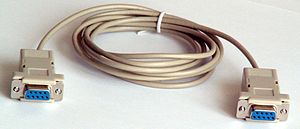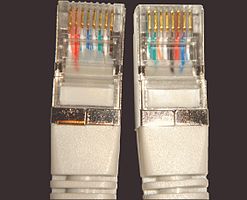- Crossover cable
-
This article is about crossover cables in general. For Ethernet crossover cables, see Ethernet crossover cable.
A crossover cable connects two devices of the same type, for example DTE-DTE or DCE-DCE, usually connected asymmetrically (DTE-DCE), by a modified cable called a crosslink.[1] Such distinction of devices was introduced by IBM.
The crossing wires in a cable or in a connector adaptor allows:
- connecting two devices directly, output of one to input of the other,
- letting two terminal (DTE) devices communicate without an interconnecting hub knot, i.e. PCs,
- linking two or more hubs, switches or routers (DCE) together, possibly to work as one wider device.
Contents
Examples
- a Null modem of RS-232
- Ethernet crossover cable
- Rollover cable
- A loopback is a type of degraded "one side crosslinked connection" connecting a port to itself, usually for test purposes.
Use crossover cables for the following connections: Switch to switch, Switch to hub, Hub to hub, Router to router, PC to PC, Router to PC
Other technologies
Some connection standards use different balanced pairs to transmit data, so crossover cables for them have different configurations to swap the transmit and receive pairs:
- Twisted pair Token ring uses T568B pairs 1 and 3 (the same as T568A pairs 1 and 2), so a crossover cable to connect two Token Ring interfaces must swap these pairs, connecting pins 4, 5, 3, and 6 to 3, 6, 4, and 5 respectively.
- A T1 cable uses T568B pairs 1 and 2, so to connect two T1 CSU/DSU devices back-to-back requires a crossover cable that swaps these pairs. Specifically, pins 1, 2, 4, and 5 are connected to 4, 5, 1, and 2 respectively.
- A 56K DDS cable uses T568B pairs 02 and 04, so a crossover cable for these devices swaps those pairs (pins 01, 02, 07, and 08 are connected to 07, 08, 01, and 02 respectively).
-
A null modem cable.
See also
References
- ^ Dean, Tamara (2010). Network+ Guide to Networks. Delmar. pp. 657.
Categories:- Signal cables
Wikimedia Foundation. 2010.


